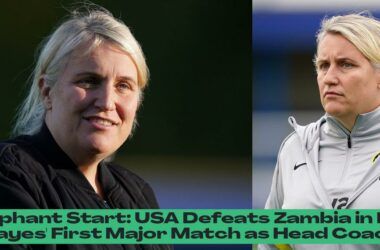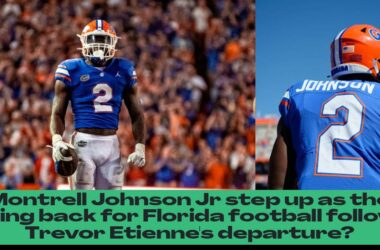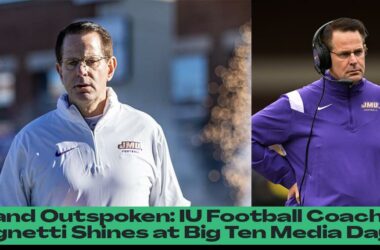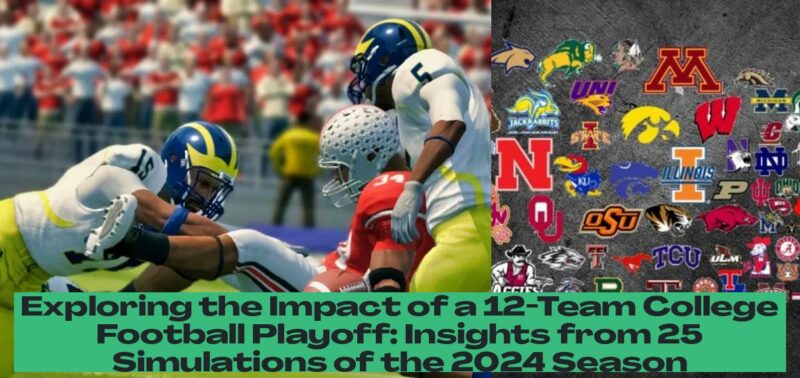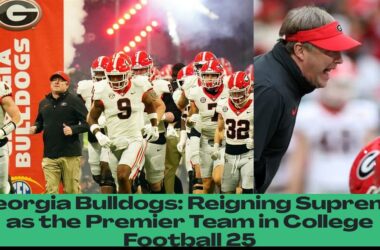Twenty-five attempts, 61 playoff teams
The expansion of the College Football Playoff from four teams to twelve this fall opens up a world of possibilities for programs across the nation. More teams have a genuine shot at entering the national championship race, and this new era of conference realignment has shaken things up considerably. To see how everything would play out in this new landscape, I embarked on a fact-finding mission: I simulated the upcoming and unprecedented 2024 season in Dynasty mode on EA Sports’ College Football 25. I wanted to see how the inaugural 12-team playoff and conference realignment would unfold. I didn’t stop at just one simulation, though. I wanted to explore the possibilities, so I ran the season over and over again until I had 25 seasons of data.
I did not play any games, I did not alter the default settings or rosters, and I did not get much sleep. After creating 25 Dynasty files, an Xbox notification urged me to stop. Still, sicko mission accomplished. Just like Doctor Strange on Titan, I went forward in time to see all the possible outcomes of the coming conflicts: conference races, Heisman winners, CFP brackets, even the coaching carousel. Here’s what I learned.
Over the course of these 25 simulations, a remarkable 61 different FBS teams earned at least one CFP appearance. That’s a testament to the expanded playoff and the increased opportunities for programs to make a run. But some teams consistently found themselves in the playoff conversation, making multiple appearances.
The 12 teams that most frequently earned playoff appearances were Michigan (23), Oregon (22), Georgia (17), Ohio State (17), Texas A&M (13), Alabama (12), Utah (11), Miami (10), Clemson (nine), Kansas State (nine), Notre Dame (nine), and Penn State (nine). These teams consistently ranked amongst the nation’s best, showcasing their talent and depth.
In the end, there were 46 teams that made multiple CFP appearances in the game. This includes some unexpected contenders like Texas Tech, Nebraska, Virginia Tech, Boston College, Iowa State, and Syracuse. These teams, while not always considered perennial powerhouses, managed to break through and make their mark on the national stage.
However, some notable programs were surprisingly absent from the Playoff in all 25 simulations. Colorado, despite having the best QB in the game and a top-20 roster, never made it to the CFP. Shedeur Sanders, the highly touted quarterback, only finished in the top five in Heisman voting once. It’s a bit of a head-scratcher, given their offensive potential. The Big 12 saw nine different teams win conference titles over the 25 sims, but the Buffs weren’t one of them.
There were several other Power 4 programs that never made the Playoff, which raised eyebrows. Iowa earned zero bids despite its excellent defense. TCU came up short every time and the computer frequently fired its coach. Indiana actually played in multiple Big Ten title games but couldn’t break through to the Playoff. And oddly enough, UCLA did win one Big Ten title yet was left out that year.
The SEC, known for its dominance in college football, had a remarkable run in these simulations. Fourteen of its 16 members achieved playoff berths over the 25 simulations. But would you have guessed it would be Texas A&M earning the second-most bids? Texas and Ole Miss got in seven times each but never managed to win it all. Missouri made it to three CFPs. LSU only got in twice.
And believe it or not, the SEC emerged with just five national champions over the 25 simulations. While the conference is undoubtedly a powerhouse, the expanded playoff field provided opportunities for other teams to shine.
Oregon is the best team in the game
One clear conclusion emerged after all those simulations: The Oregon Ducks are extremely tough to beat in CFB25. Their dominance shines through in every aspect of the game.
The newest member of the Big Ten won 15 conference titles in its 25 attempts, went all the way to the CFP title game a dozen times, and won nine national championships. That’s a remarkable run of success, showcasing their consistently high level of play.
This dominance isn’t a surprise to anyone who has played with super senior QB Dillon Gabriel and his wide receiver trio of Evan Stewart, Tez Johnson, and Traeshon Holden. The Ducks’ offensive dominance shows up over and over again when you skim through the CFP box scores and end-of-season statistics in these simulations. Gabriel frequently puts up more than 5,000 yards and 50 TDs in this offense and became a Heisman Trophy finalist in eight different seasons.
Thanks to the addition of Oregon, the Big Ten secured 15 of the 25 national titles. Many of those seasons came down to Oregon-Michigan, Oregon-Ohio State, or Michigan-Ohio State facing off three times between the regular season, Big Ten title game, and Playoff. These matchups were consistently exciting and showcased the best of the conference’s talent.
Michigan, Ohio State, and Georgia each secured three national titles over the 25 simulations, demonstrating their consistently strong programs. Alabama and Clemson won one apiece, proving they still have the potential to contend for the championship. The five other national champions were shockers, and we’ll get to them soon.
The Heisman results
Four players emerged as the most consistent contenders for the Heisman: Gabriel, Alabama quarterback Jalen Milroe, Georgia quarterback Carson Beck, and Ohio State quarterback Will Howard. These quarterbacks consistently performed at a high level, demonstrating their talent and leadership.
Milroe took home the trophy four times. So did Beck. Gabriel won three. Howard, Utah QB Cameron Rising, and Liberty QB Kaidon Salter each won twice. These players were consistently among the nation’s best, showcasing their skills and leading their teams to success.
If you’re handicapping the 2024 Heisman race right now, those names are already high on the list. But the fun of this video game is all the random chaotic things that can occur in Dynasty mode when you hit sim on a season and let the computer go to work.
Ole Miss QB Jaxson Dart winning the Heisman sounds plausible. Grayson McCall (NC State), KJ Jefferson (UCF), and Behren Morton (Texas Tech) winning one is a little less likely but not impossible. But the game gave us several more stunning dark horse wins.
How about former Baylor and USF QB Gerry Bohanon delivering a Heisman in his debut season at BYU and getting his team to the CFP semifinals? Purdue’s Hudson Card won it one year after leading the Boilermakers to 11 wins and a CFP bid. South Carolina’s LaNorris Sellers got a Heisman after accounting for 47 touchdowns in his redshirt freshman season.
The greatest wild card of them all: Memphis wide receiver Koby Drake. Not familiar with his game? In one simulated season, the 5-foot-11 slot receiver caught 89 passes for 1,545 yards and 22 TDs on a Tigers squad that won the AAC but missed the Playoff. Howard was the runner-up that year and responded to the snub by leading Ohio State to a national title.
Several Group of 5 quarterbacks—including Seth Henigan (Memphis), Jordan McCloud (Texas State), Jacob Zeno (UAB), and Tucker Gleason (Toledo)—pulled off second-place finishes in Heisman voting. It’s a quarterback award in this game. Ollie Gordon II and Donovan Edwards were consistently among the nation’s leading rushers but never finished in the top five in Heisman voting, and wide receivers (other than Drake) were rarely in the mix.
The wildest Playoff of them all
In real life, we’re probably going to get a College Football Playoff in 2024 that ends with Georgia, Ohio State, Oregon, or another loaded powerhouse emerging victorious. Personally, I hope we get something as crazy as the fifth season in my run of 25 simulations. Let’s call it Season E.
Boise State defeats Nevada in the Mountain West title game to grab a Playoff bid. The Broncos are No. 21 in the final CFP rankings and get the No. 12 seed. They draw a 10-3 Alabama team in the first round and go down to Tuscaloosa and deliver a 49-14 beatdown. But there’s bad news: starting QB Malachi Nelson exits the game with a season-ending torn hamstring.
Boise State has to roll with 5-foot-10 backup Maddux Madsen, but the show goes on. The sophomore leads his squad to upset wins over No. 4 Miami and No. 8 Utah to reach the national title game. Then he throws for 329 yards and three TDs against Michigan’s defense and Boise State pulls off a fourth-quarter comeback for a 35-31 triumph. Madsen becomes an instant college football legend.
Who wouldn’t want to watch Season E?
The greatest comeback
Season W was another all-timer for CFP madness. Clemson fans aren’t going to like how it starts, but they’ll love how it ends.
Clemson gets off to a brutal 0-3 start and QB Cade Klubnik is injured for the rest of the regular season. Redshirt freshman backup Christopher Vizzina steps in, turns things around, and the Tigers go 8-4 and reach the ACC title game thanks to a four-way tie in the conference standings. Klubnik is cleared to play in the game and leads an upset win over Boston College. Clemson finishes No. 21 in the final CFP rankings but is the No. 4 seed in the bracket thanks to its automatic bid.
For the Tigers, it turns out to be one heck of a draw. They get to face two ACC foes, defeating No. 5 Stanford in the Rose Bowl and No. 9 Miami in the Orange Bowl semifinal. On the other side of the bracket, Iowa State and Nebraska take down Georgia and Ohio State, respectively. After Nebraska’s head coach accepts the Auburn job mid-Playoff—yep, seriously—the Cyclones knock the Huskers off in the Cotton Bowl semi.
In the season finale, Klubnik throws for 330 yards and five TDs in a 38-21 rout, and the four-loss Tigers are the national champs.
Surprise contenders
Over these 25 simulations, the Big 12 produced four CFP national champions. Kansas State won two of them with Avery Johnson. The first one required wins over Tennessee, Florida, and Georgia in their bracket. The second was just as epic: The Wildcats ruined a perfect 15-0 season for Oregon with a 48-46 upset in triple overtime.
Utah also pulled off a title game stunner against Oregon in a showdown of former Pac-12 foes. The Ducks were the No. 1 seed again in that season but couldn’t stop Rising (460 yards, six TDs) and his receiving duo of Money Parks and Dorian Singer.
We also had an all-Big 12 national championship game in another season when Oklahoma State met Kansas. The Cowboys got there thanks to a 200-yard performance from Ollie Gordon II to defeat the Ducks in the Rose Bowl. Gordon finished No. 2 nationally in rushing with more than 1,500 yards and 20 TDs and led a 42-14 rout in the title game.
A few more unexpected playoff runs that stood out over the 25 simulations:
- North Carolina made it all the way to the CFP championship game as a No. 12 seed by stunning Alabama and Texas. Oregon handed the Heels a 38-point loss in the title game.
- Wisconsin got a terrific season from transfer QB Tyler Van Dyke (40 TDs, 7 INTs) and played for a national title. After losing to Georgia, the Badgers’ head coach left for the NFL.
- Boston College, NC State, and SMU each put together dream seasons and played in CFP semifinals. The Mustangs’ playoff run, during their debut season in the ACC, included an incredible 59-57 triple overtime win over North Texas in the Peach Bowl. Preston Stone and Chandler Morris combined for more than 900 yards and 14 TDs in the shootout.
- Florida had two seasons end in the Playoff semifinals and 12 other seasons end with a coaching change.
Conference title scoreboard
Here are the conference title game winners over the 25 simulations. This should inspire a little hope for a few fan bases wondering whether their team can make a run this year. (Scroll to the right for the full list of winners).
| Conference | Most common champ |
|—|—|
| ACC | Miami (4), Clemson (4), Florida State (4), North Carolina (3), Boston College (2), Louisville (1), SMU (1), Virginia Tech (1) |
| Big Ten | Ohio State (4), Michigan (3), Nebraska (1), UCLA (1), Wisconsin (1) |
| Big 12 | Utah (6), Texas Tech (4), Oklahoma State (3), Kansas (2), Arizona (1), BYU (1), Cincinnati (1), Iowa State (1) |
| SEC | Texas A&M (4), Florida (3), Alabama (2), Oklahoma (2), Texas (2), Kentucky (2), LSU (1), Missouri (1), Ole Miss (1) |
| AAC | Tulane (4), UAB (4), ECU (3), North Texas (3), Rice (3), Charlotte (1), FAU (1) |
| CUSA | Western Kentucky (6), Middle Tennessee (3), Jacksonville State (2), Louisiana Tech (2), FIU (1), Sam Houston (1) |
These simulations paint a fascinating picture of the potential landscape of college football in 2024. While some teams consistently emerged as contenders, others pulled off unexpected runs, and some surprising underdogs found themselves in the national championship race. The expanded playoff field has created a more competitive environment, and the unpredictable nature of the game is truly on display. As the season approaches, these simulations offer a glimpse into the possibilities, and as fans, we can only wait with anticipation to see how the real season unfolds.
- Expanding the College Football Playoff to twelve teams has opened up more opportunities for programs across the nation.
- Simulating the 2024 season in Dynasty mode on EA Sports’ College Football 25 provided insights into how the new playoff format and conference realignment would unfold.
- Running 25 simulations of the season revealed that a total of 61 different FBS teams earned at least one CFP appearance, showcasing increased parity and competitiveness.
- Michigan, Oregon, Georgia, Ohio State, Texas A&M, Alabama, Utah, Miami, Clemson, Kansas State, Notre Dame, and Penn State were among the top teams with multiple playoff appearances in the simulations.
- 46 teams made multiple CFP appearances in the game, including unexpected contenders like Texas Tech, Nebraska, Virginia Tech, and Boston College.

